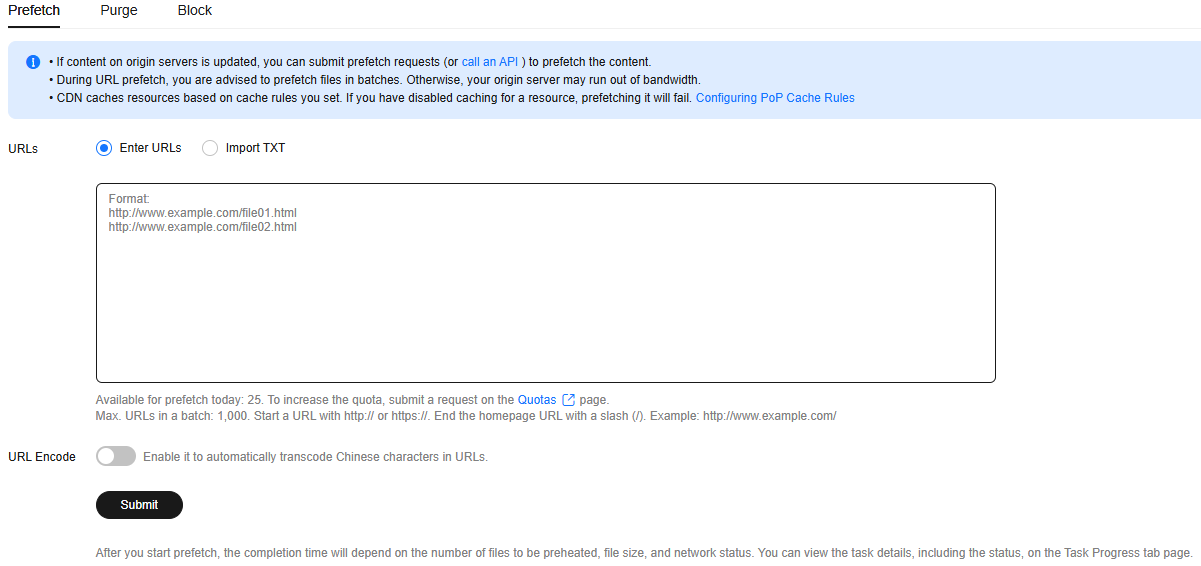Cache Prefetch
CDN simulates user requests and caches resources to CDN PoPs, so that users can obtain the latest resources from the nearest CDN PoP.
Typical Scenarios
Initial access: When you connect a domain name to CDN for the first time, you can prefetch large files including videos to improve user experience.
Installation package release: Before releasing a software installation package or upgrade package, you can prefetch the content to the globally distributed CDN PoPs. After the software or upgrade is launched, the CDN PoPs directly respond to the download requests of a large number of users, which improves the download speed and greatly reduces the pressure on your origin server.
Promotional activity: Before releasing a promotional campaign, you can prefetch the static content involved on the activity page to CDN PoPs. After the activity starts, the CDN PoPs respond to user requests for accessing all static content, which ensures service availability and improves user experience.
Precautions
- Cache prefetch can be performed only for unbanned domain names in Enabled or Configuring state. For more information about the domain status, see Viewing Basic Domain Information.
- After cache prefetch is executed, resources are prefetched to the CDN central PoPs within the service area of the domain name by default.
- The time required to complete a prefetch task depends on the number and size of target files, and on network conditions.
- If the cache prefetch status of a URL is Completed, the prefetch is complete.
- Prefetching a large number of files may fully occupy the bandwidth resources of the origin server. Therefore, you are advised to prefetch files in batches.
- Dynamic files, such as ASP, JSP, and PHP files, cannot be prefetched.
- If you have disabled caching for a resource, prefetching it will fail.
- You can also create a cache prefetch task for a domain name by calling an API. For details, see API Overview.
Procedure
- Log in to the CDN console.
- In the navigation pane, choose .
- Click the Prefetch tab and enter URLs to be prefetched or import a TXT file.
Figure 1 Cache prefetch

Table 1 Parameter description Type
Description
URL prefetch
- CDN prefetches a specific file.
Requirements of entered URLs:
- http:// or https:// must be included.
- Enter one URL per row.
- End the homepage URL with a slash (/). Example: http://www.example.com/
- Each account can prefetch a maximum of 1,000 URLs per day or per task.
http://www.example.com/file01.html
http://www.example.com/file02.html
https://example.huawei.com/download/app/abc.apk
Requirements of URLs in imported TXT files:- Start a URL with http:// or https:// in the TXT file.
- Enter one URL per row.
- End the homepage URL with a slash (/). Example: http://www.example.com/
- The number of URLs in the TXT file cannot exceed the remaining URL quota.
URL Encode
If enabled, Chinese characters in URLs are automatically transcoded and only content of transcoded URLs is prefetched.
- Click Submit to deliver the cache prefetch task.
- Submitted prefetch tasks cannot be canceled. You can view the task status on the Task Progress tab.
- If your account quota is insufficient, click Quotas under the text box to apply for a higher quota.
Operation Logs and URL Query
- After submitting a prefetch task, view the operation log in the lower part of the page. Click Check Details in the Operation column to export the list of URLs submitted in the task or view the failure cause.
Figure 2 Operation logs

- Click the URL Query tab to query the prefetched URLs in the last 15 days. Click Resubmit in the Operation column to prefetch a URL again.
Figure 3 URL query

Feedback
Was this page helpful?
Provide feedbackThank you very much for your feedback. We will continue working to improve the documentation.See the reply and handling status in My Cloud VOC.
For any further questions, feel free to contact us through the chatbot.
Chatbot





